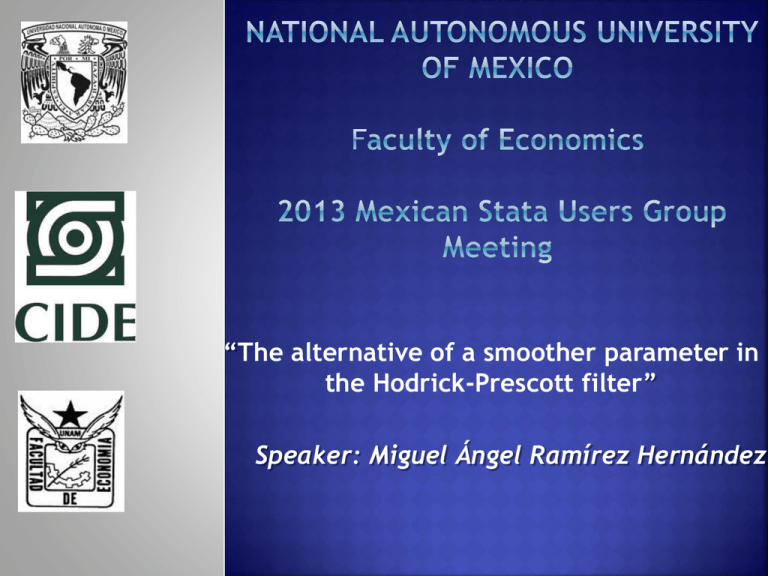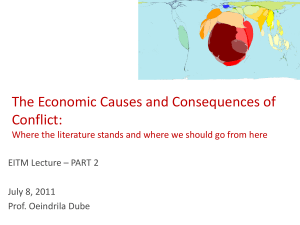Time Series
advertisement

“The alternative of a smoother parameter in
the Hodrick-Prescott filter”
Speaker: Miguel Ángel Ramírez Hernández
Time
Series: Retrospective, definition and
components.
The
Hodrick-Prescott filter (1997) and
criticism of the smoothing parameter (λ).
Proposal,
simulation and empirical
evidence.
References.
Miguel Ángel Ramírez Hernández
2
“Every kind of periodic
fluctuation, whether daily,
weekly, monthly, quarterly, or
yearly, must be detected and
exhibited, not only as a subject of
study in itself, but because we
must ascertain and eliminate such
periodic variations before we can
correctly exhibit those which are
irregular or non-periodic, and
probably of more interest
importance”1
William Stanley Jevons
1862
1Jevons,
W.S. (1884). Investigations in
currency and finance. London: Macmillan
and Co. page 4.
Miguel Ángel Ramírez Hernández
3
In the half nineteenth century: W. S. Jevons (1862)
pioneered the analysis of time series.
Early twentieth century Hooker (1901): Concept
trend.
First half of the twentieth century
Study of business cycles:
Kitchin (1923) and Frickey (1934).
Formalizing cyclic models:
Kuznets (1929); Frisch (1933); Samuelson (1939);
Kaldor (1940); Metzler (1941) and Tinbergen
(1939.1940, 1942).
1950-1960: period of "steady state" in the level
intellectual of cycles.
Miguel Ángel Ramírez Hernández
4
1970-1980:
early distinction of economic cycles,
growth cycles and political-economic cycles, Nordhaus
(1975).
Simultaneously, Lucas (1975) with notable differences:
General Economic Cycle (GEC).
From GEC were raised derivations with rational
expectation. Development of "RBC“ models.
Kydland-Prescott (1982): prototype RBC
Long and Plosser (1983).
1980-1990:
special interest
decomposition: trend-cycle.
in
time
series
Harvey (1985) and Hodrick-Prescott (1997). Extensive
use in RBC models.
Miguel Ángel Ramírez Hernández
5
Time series definition
Probability space: (, , P )
“y” is a random variable, real function defined in
that for every real number “a”
Thus, for each “a”:
such
Aa w | y(w) a
F : R 0,1
F (a) P( Aa )
Therefore, a random vector or vector of random variables of
dimension K is a function “y" of in Euclidean space Rk
y w y1 w,..., yk w´
a (a1 ,...,ak )´ R k
Aa w | y1 ( w) a1 ,..., yk | ( w) ck
Miguel Ángel Ramírez Hernández
6
F : R k 0,1
F (a) P( Aa )
Distribution function “y”
Assuming an index set Z that contains non-negative integers,
discrete stochastic process is a real function:
t Z, y (t , w)
y:Z R
Generally, the random variable corresponding to "t" is
denoted as {yt}.
Finally, a time series is defined as an underlying stochastic
process embodiment and whose order performs to
equidistant frequency.
Miguel Ángel Ramírez Hernández
7
1)
Persons (1919) identified four components of the time
series:
A long-term development (trend).
2)
A cyclical component with periods longer than t +1
(cycle).
3)
A component that contains fluctuations up and down
within a year (seasonal cycle / seasonal).
4)
A component excluding movements in 1), 2) and 3).
(residual / irregular/random element).
Miguel Ángel Ramírez Hernández
8
Define a time series yt as the sum of a component of
"growth" and a cyclical component :
yt gt ct for t 1,2,3,..T
Optimization process particular: minimizing the variance
of cyclical component and the variance of trend "second
difference of serie".
2
T
T
2
min
c
g
g
(
g
g
)
t
t
t 1
t 1
t 2
g t Tt 1 t 1
t 1
Smoothing parameter: λ
12
2
2
Source: Authors' calculations based on Hodrick and Prescott (1997).
Miguel Ángel Ramírez Hernández
9
The evidence and relevance of λ smoothing factors that
suggest the authors to annual data is 100 and 1600 for
quarterly data.
However, the parameter λ has a number of
inconsistencies outlined mainly by Cogley and Nason
(1995); Guay, ST-Amant (2005).
Reviews:
1.
The trend and cycle components present deviations prominent
when the estimator λ is not consistent.
2.
Real Cycles Spurious, derivatives of overidentifying in the order
of time series.
3.
Variance and trend cycle series are particular; assume a priori
smoothing factors can disturb inferences, for example, the
unemployment rate and the natural rate estimates by the HP
filter.
Miguel Ángel Ramírez Hernández
10
i.
Proposal: Promptly identify the order of
integration of the trend and proceed to use
the corresponding variance.
ii.
Consider and weight the factor λ by a
coefficient inverse of "angular frequency".
12
af 2
2
Where:
1
af
T
Miguel Ángel Ramírez Hernández
11
Matrix estimation
In terms of Hodrick-Prescott (1997)
yt ( y1 , y2 ,..., yT ), yt RT
g t RT
yt gt ct
c RT
If the smoothing parameter is non-negative, i.e. λ> 0, the
breakdown of the series yt is obtained by minimizing the
weighted sum of squares with respect to gt :
2
yg g
R
2
2
T
Note: Stata incorporates hprescott command.
Miguel Ángel Ramírez Hernández
12
The unique solution of the minimization is defined as:
g , y I Z´Z y
1
Where Z denotes a particular matrix, dimension T 2 T and
“I” denotes the identity matrix.
Z T 2T
1 2 1
0 1 2
:
... ... ...
0 ... ...
Miguel Ángel Ramírez Hernández
... ...
1 ...
... ...
1 2
0
0
...
1
13
Simulation in Stata
Step 1: Define the matrix Z.
mkmat … … … …, matrix(Z)
mat list Z
Step 2: Estimate the transpose of Z.
matrix Z´=Z’
mat list Z’
Step 3: Define the identity matrix I.
mkmat … … …, matrix(identity)
mat list identity
Step 4: Multiply the transpose matrix Z by matrix Z.
matrix Z´Z=Z’*Z
Step 5: Estimate the smoothing parameter λ and multiply this
scalar by the result of the matrix obtained in Step 4.
matrix lambdaZ´Z= λ *Z´Z
Miguel Ángel Ramírez Hernández
14
Step 6: The result obtained in step 5, add the identity
matrix.
matrix lambdaZ´Z+I=identity+lambdaZ´Z
mat list lambdaZ´Z+I
Step 7: Estimate inverse of the resulting matrix in step 6.
matrix inversalambdaZ´Z+I=invsym(lambdaZ´Z+I)
Step 8: Enter the time series
mkmat serie
matlist
Step 9: Finally multiply the vector of the time series
estimated by the matrix in step 7.
Outcome: Trend of the time series.
Note: The cycle component is obtained by subtracting the
trend component in original time series.
Miguel Ángel Ramírez Hernández
15
I extracted the real effective exchange rate of
Norway (REER) for a quarterly period 1980-I to
2008-III.
Objective: To analyze the changes in the balance
of goods and non-factor services. (REER-proxy).
Miguel Ángel Ramírez Hernández
16
4.65
Norway: real effective exchange rate and HP filters with
variations in the smoothing parameter, 1980-I to 2008-III.
Serie LTCR
lambda=1600
lambda=13.08159669
lambda=239.4300893
4.5
4.55
4.6
Alternative proposal
1980-1
1990-1
2000-1
2010-1
Source: Authors' calculations based on IMF and Central Bank of
Norway (2013).
Simulated data in Stata.
Miguel Ángel Ramírez Hernández
17
o
o
o
o
o
o
o
o
o
o
Cogley, T. and Nason, J.M. (1995), “Effects of the Hodrick–Prescott filter on trend
and difference stationary time series. Implications for business cycle research”,
Journal of Economic Dynamics and Control, 19, 253–278.
Frickey, E. (1934), “The problem of secular trend”, Review of Economics and
Statistics, 16, 199–206.
Frisch, R. (1933), “Propagation problems and impulse problems in dynamic
economics”, in Economic Essays in Honour of Gustav Cassel, London: George
Allen & Unwin, 171–205.
Guay, A. y St.-Amant, P. (2005). “Do the Hodrick-Prescott and Baxter-King Filters
Provide a Good Approximation of BusinessCycles. Annals of Economics and
Statistics / Annales dӃconomie et de Statistique, 77,133-155.
Harvey, A.C. (1985), “Trends and cycles in macroeconomic time series”, Journal
of Business and Economic Statistics, 3, 216–227.
Hodrick, R.J. and Prescott, E.C. (1997). “Postwar US business cycles: an
empirical investigation”, Journal of Money, Credit and Banking, 29, 1–16.
Hooker, R.H. (1901), “Correlation of the marriage rate with trade”, Journal of
the Royal Statistical Society, 64, 485–503.
Kaldor, N. (1940), “A model of the trade cycle”, Economic Journal, 50, 78–92.
Kitchin, J. (1923), “Cycles and trends in economic factors”, Review of Economics
and Statistics, 5, 10–16.
Kuznets, S. (1929), “Random events and cyclical oscillations”, Journal of the
American Statistical Association, 24, 258–275.
Continue…
Miguel Ángel Ramírez Hernández
18
o
o
o
o
o
o
o
o
o
o
o
Kydland, F.E. and Prescott, E.C. (1982), “Time to build and aggregate
fluctuations”, Econometrica, 50, 1345–1370.
Jevons, W.S. (1884). Investigations in currency and finance. London:
Macmillan and Co. page 4.
Long, J.B. and Plosser, C.I. (1983), “Real business cycles”, Journal of
Political Economy, 91, 39–69.
Lucas, R.E. (1975), “An equilibrium model of the business cycle”, Journal
of Political Economy, 83, 1113–1144.
Metzler, L.A. (1941), “The nature and stability of inventory cycles”,
Review of Economics and Statistics, 23, 113–129.
Nordhaus, W.D. (1975), “The political business cycle”, Review of
Economic Studies, 42, 169–190.
Persons, W.M. Indices of Business Conditions, Review of Economic
Statistics (1919), pp. 5 – 107.
Samuelson, P.A. (1939), “Interactions between the multiplier analysis and
the principle of the accelerator”, Review of Economics and Statistics, 21,
75–78.
Tinbergen, J. (1939b), Statistical Testing of Business-Cycle Theories,
Volume 1I: Business Cycles in the United States of America, Geneva:
League of Nations.
Tinbergen, J. (1940), “On a method of statistical business-cycle research.
A reply”, Economic Journal, 50, 141–154.
Tinbergen, J. (1942), “Critical remarks on some business-cycle theories”,
Econometrica, 10, 129–146.
Miguel Ángel Ramírez Hernández
19








